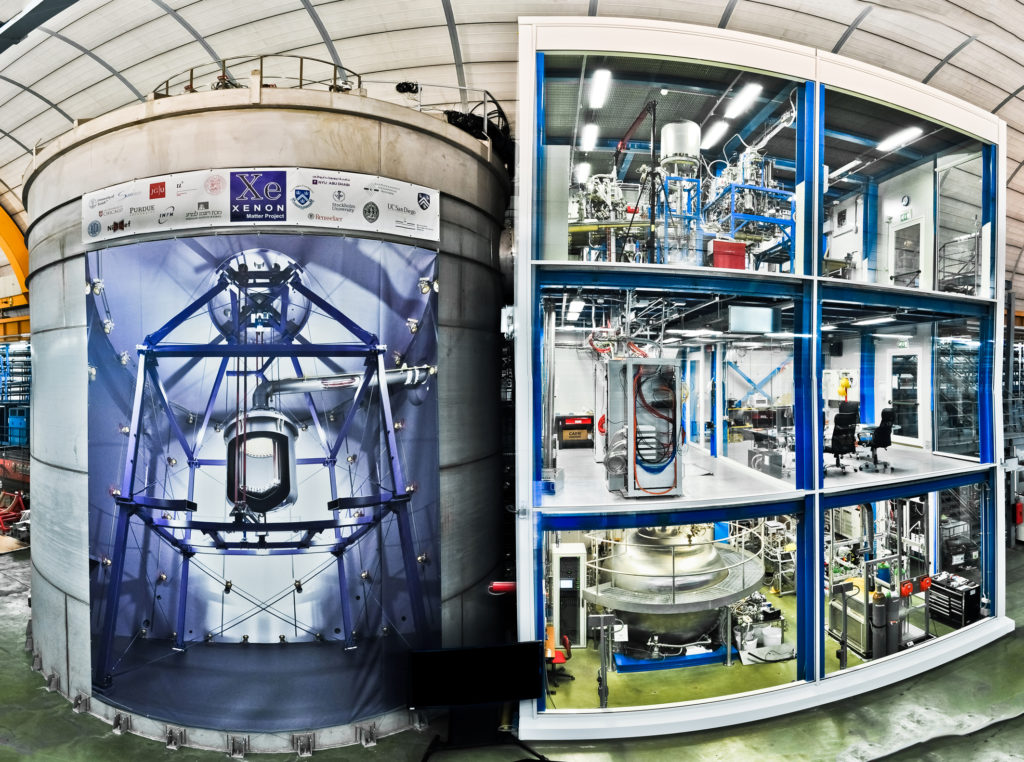PageContent
XENON
XENON is an international scientific collaboration with participant institutions spread across three continents (Europe, America and Asia). XENON is the world leading project for the direct search of dark matter: a fundamental constituent of the Universe. We know that dark matter exists and it is much more abundant than ordinary matter. However, dark matter has never been observed thus far. A direct evidence of its presence would be a milestone in the history of physics and a huge step forward for our understanding of the Universe.
The XENON experiments, hosted at the underground INFN Gran Sasso National Laboratory (LNGS), operate time projection chambers (TPC) detectors to catch interactions of dark matter particles with a liquid xenon (LXe) target. The first experiment, XENON10 (2005), and its successor, XENON100 (2009), obtained the world’s best results on the direct dark matter search.
The collaboration has opened the ton-scale era of dark matter detectors with the XENON1T experiment (2016), by operating a TPC filled with 2 tonnes of LXe. The very large target and the lowest background level ever allowed XENON1T to reach an unprecedented sensitivity to dark matter, but not only. Indeed, XENON1T was able to detect the rarest process ever observed in human history: the double electron capture decay of 124Xe. The upgrade XENONnT represents the current phase of the XENON project with a bigger target (a total of about 8 tonnes of LXe) and a lower background.

INFN Bologna activities
The XENON group of Bologna joined the collaboration in 2013 and its activities cover several areas of the experimental research project.
Muon Veto The muon veto system of the XENON1T and XENONnT experiments has been designed, tested and installed under the direction of the Bologna group, which mantains the system and analyze its data. Such large water Cherenkov detector allows to suppress the background due to neutrons induced by cosmic muons that penetrate the Gran Sasso mountain and reach the LNGS experimental hall.
Neutron Veto Differently from XENON1T, the XENONnT experiments has an additional detector surrounding the TPC. This is the neutron veto, which acts against neutrons originated from material radioactivity. The Bologna group is responsible for the system, from its design to the installation, operation and maintenance.
Monte Carlo Simulations The Bologna group plays a coordinating role in the simulation activities of the experiment and in the study of the background sources for both XENON1T and XENONnT. Such simulations are fundamental to characterize the detector response and predict the expected background from ordinary particle interactions.
Data Analysis The analysis of the XENON1T data, that produced the best results currently available on direct dark matter research, was conducted with the contribution of the Bologna group. The commitment to data analysis will also continue in XENONnT.
XENON INFN Bologna members
| Gabriella Sartorelli Professore ordinario PI XENON Bologna gabriella.sartorelli@bo.infn.it +39 051 20 9 1062 |
Marco Selvi Primo ricercatore INFN Responsabile nazionale XENON marco.selvi@bo.infn.it +39 051 20 9 1120 |
| Graziano Bruni Dirigente di ricerca INFN graziano.bruni@bo.infn.it +39 051 20 9 1057 |
Lorenzo Bellagamba Primo ricercatore INFN bellagamba@bo.infn.it +39 051 20 9 1082 |
| Franco Semeria Primo tecnologo INFN semeria@bo.infn.it +39 051 20 9 1192 |
Federica Agostini Assegnista di ricerca federica.agostini@bo.infn.it |
| Pietro Di Gangi Assegnista di ricerca pietro.digangi@bo.infn.it +39 051 20 9 1130 |












